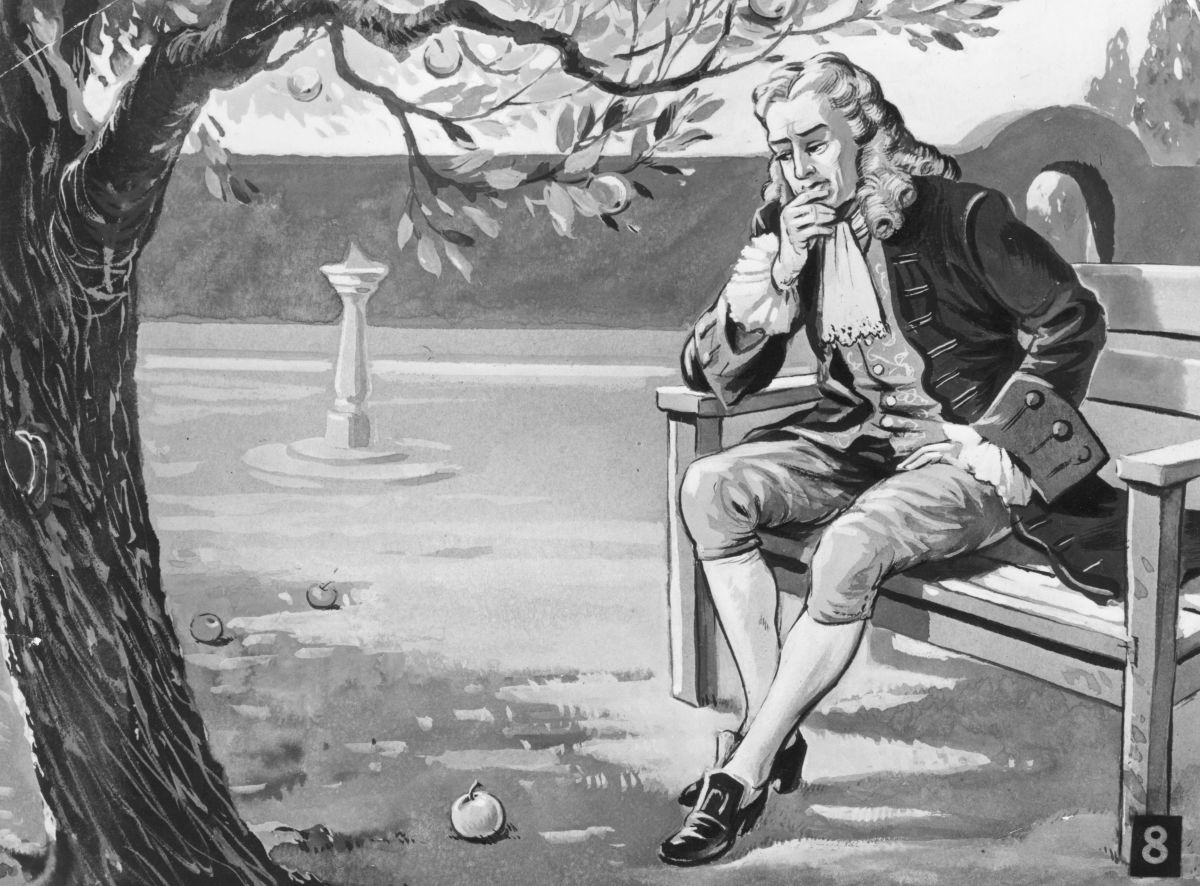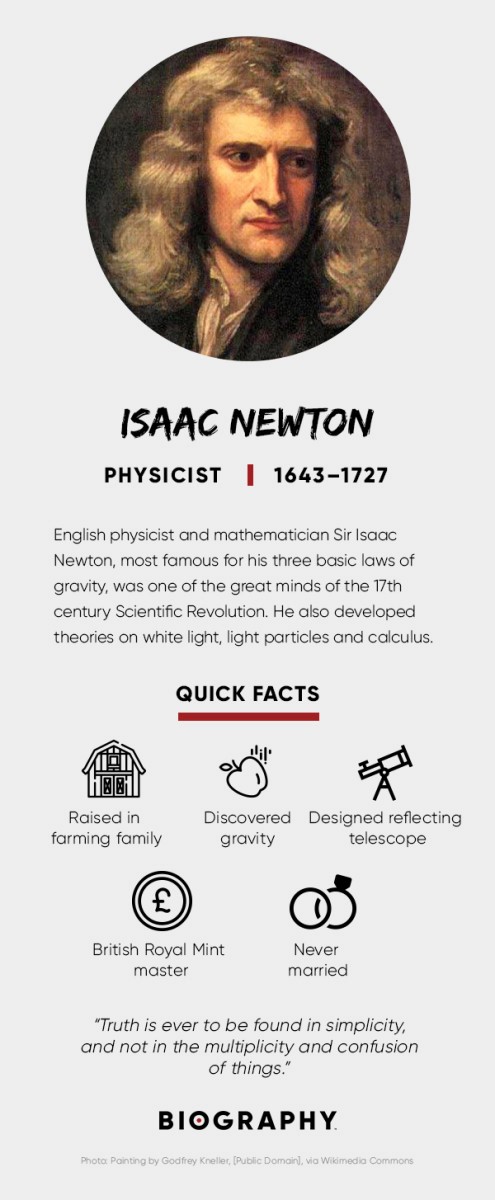Isaac Newton was an English physicist and mathematician famous for his laws of physics. He was a key figure in the Scientific Revolution of the 17th century.
Who Was Isaac Newton?
Isaac Newton was a physicist and mathematician who developed the principles of modern physics, including the laws of motion and is credited as one of the great minds of the 17th-century Scientific Revolution.
In 1687, he published his most acclaimed work, Philosophiae Naturalis Principia Mathematica (Mathematical Principles of Natural Philosophy), which has been called the single most influential book on physics. In 1705, he was knighted by Queen Anne of England, making him Sir Isaac Newton.
Early Life and Family
Newton was born on January 4, 1643, in Woolsthorpe, Lincolnshire, England. Using the "old" Julian calendar, Newton's birth date is sometimes displayed as December 25, 1642.
Newton was the only son of a prosperous local farmer, also named Isaac, who died three months before he was born. A premature baby born tiny and weak, Newton was not expected to survive.
When he was 3 years old, his mother, Hannah Ayscough Newton, remarried a well-to-do minister, Barnabas Smith, and went to live with him, leaving young Newton with his maternal grandmother.
The experience left an indelible imprint on Newton, later manifesting itself as an acute sense of insecurity. He anxiously obsessed over his published work, defending its merits with irrational behavior.
At age 12, Newton was reunited with his mother after her second husband died. She brought along her three small children from her second marriage.
Isaac Newton's Education
Newton was enrolled at the King's School in Grantham, a town in Lincolnshire, where he lodged with a local apothecary and was introduced to the fascinating world of chemistry.
His mother pulled him out of school at age 12. Her plan was to make him a farmer and have him tend the farm. Newton failed miserably, as he found farming monotonous. Newton was soon sent back to King's School to finish his basic education.
Perhaps sensing the young man's innate intellectual abilities, his uncle, a graduate of the University of Cambridge's Trinity College, persuaded Newton's mother to have him enter the university. Newton enrolled in a program similar to a work-study in 1661, and subsequently waited on tables and took care of wealthier students' rooms.
Scientific Revolution
When Newton arrived at Cambridge, the Scientific Revolution of the 17th century was already in full force. The heliocentric view of the universe—theorized by astronomers Nicolaus Copernicus and Johannes Kepler, and later refined by Galileo—was well known in most European academic circles.
Philosopher René Descartes had begun to formulate a new concept of nature as an intricate, impersonal and inert machine. Yet, like most universities in Europe, Cambridge was steeped in Aristotelian philosophy and a view of nature resting on a geocentric view of the universe, dealing with nature in qualitative rather than quantitative terms.
During his first three years at Cambridge, Newton was taught the standard curriculum but was fascinated with the more advanced science. All his spare time was spent reading from the modern philosophers. The result was a less-than-stellar performance, but one that is understandable, given his dual course of study.
It was during this time that Newton kept a second set of notes, entitled "Quaestiones Quaedam Philosophicae" ("Certain Philosophical Questions"). The "Quaestiones" reveal that Newton had discovered the new concept of nature that provided the framework for the Scientific Revolution. Though Newton graduated without honors or distinctions, his efforts won him the title of scholar and four years of financial support for future education.
In 1665, the bubonic plague that was ravaging Europe had come to Cambridge, forcing the university to close. After a two-year hiatus, Newton returned to Cambridge in 1667 and was elected a minor fellow at Trinity College, as he was still not considered a standout scholar.
In the ensuing years, his fortune improved. Newton received his Master of Arts degree in 1669, before he was 27. During this time, he came across Nicholas Mercator's published book on methods for dealing with infinite series.
Newton quickly wrote a treatise, De Analysi, expounding his own wider-ranging results. He shared this with friend and mentor Isaac Barrow, but didn't include his name as author.
In June 1669, Barrow shared the unaccredited manuscript with British mathematician John Collins. In August 1669, Barrow identified its author to Collins as "Mr. Newton ... very young ... but of an extraordinary genius and proficiency in these things."
Newton's work was brought to the attention of the mathematics community for the first time. Shortly afterward, Barrow resigned his Lucasian professorship at Cambridge, and Newton assumed the chair.
Isaac Newton’s Discoveries
Newton made discoveries in optics, motion and mathematics. Newton theorized that white light was a composite of all colors of the spectrum, and that light was composed of particles. His momentous book on physics, Principia, contains information on nearly all of the essential concepts of physics except energy, ultimately helping him to explain the laws of motion and the theory of gravity. Along with mathematician Gottfried Wilhelm von Leibniz, Newton is credited for developing essential theories of calculus.
Isaac Newton Inventions
Newton's first major public scientific achievement was designing and constructing a reflecting telescope in 1668. As a professor at Cambridge, Newton was required to deliver an annual course of lectures and chose optics as his initial topic. He used his telescope to study optics and help prove his theory of light and color.
The Royal Society asked for a demonstration of his reflecting telescope in 1671, and the organization's interest encouraged Newton to publish his notes on light, optics and color in 1672. These notes were later published as part of Newton's Opticks: Or, A treatise of the Reflections, Refractions, Inflections and Colours of Light.

Photo: Hulton Archive/Getty Images
Sir Isaac Newton contemplates the force of gravity, as the famous story goes, on seeing an apple fall in his orchard, circa 1665.
The Apple Myth
Between 1665 and 1667, Newton returned home from Trinity College to pursue his private study, as school was closed due to the Great Plague. Legend has it that, at this time, Newton experienced his famous inspiration of gravity with the falling apple. According to this common myth, Newton was sitting under an apple tree when a fruit fell and hit him on the head, inspiring him to suddenly come up with the theory of gravity.
While there is no evidence that the apple actually hit Newton on the head, he did see an apple fall from a tree, leading him to wonder why it fell straight down and not at an angle. Consequently, he began exploring the theories of motion and gravity.
It was during this 18-month hiatus as a student that Newton conceived many of his most important insights—including the method of infinitesimal calculus, the foundations for his theory of light and color, and the laws of planetary motion—that eventually led to the publication of his physics book Principia and his theory of gravity.
Isaac Newton’s Laws of Motion
In 1687, following 18 months of intense and effectively nonstop work, Newton published Philosophiae Naturalis Principia Mathematica (Mathematical Principles of Natural Philosophy), most often known as Principia.
Principia is said to be the single most influential book on physics and possibly all of science. Its publication immediately raised Newton to international prominence.
Principia offers an exact quantitative description of bodies in motion, with three basic but important laws of motion:
First Law
A stationary body will stay stationary unless an external force is applied to it.
Second Law
Force is equal to mass times acceleration, and a change in motion (i.e., change in speed) is proportional to the force applied.
Third Law
For every action, there is an equal and opposite reaction.
Newton and the Theory of Gravity
Newton’s three basic laws of motion outlined in Principia helped him arrive at his theory of gravity. Newton’s law of universal gravitation states that two objects attract each other with a force of gravitational attraction that’s proportional to their masses and inversely proportional to the square of the distance between their centers.
These laws helped explain not only elliptical planetary orbits but nearly every other motion in the universe: how the planets are kept in orbit by the pull of the sun’s gravity; how the moon revolves around Earth and the moons of Jupiter revolve around it; and how comets revolve in elliptical orbits around the sun.
They also allowed him to calculate the mass of each planet, calculate the flattening of the Earth at the poles and the bulge at the equator, and how the gravitational pull of the sun and moon create the Earth’s tides. In Newton's account, gravity kept the universe balanced, made it work, and brought heaven and Earth together in one great equation.
Flamsteed was finally able to get a court order forcing Newton to cease his plans for publication and return the notes—one of the few times that Newton was bested by one of his rivals
Final Years
Toward the end of this life, Newton lived at Cranbury Park, near Winchester, England, with his niece, Catherine (Barton) Conduitt, and her husband, John Conduitt.
By this time, Newton had become one of the most famous men in Europe. His scientific discoveries were unchallenged. He also had become wealthy, investing his sizable income wisely and bestowing sizable gifts to charity.
Despite his fame, Newton's life was far from perfect: He never married or made many friends, and in his later years, a combination of pride, insecurity and side trips on peculiar scientific inquiries led even some of his few friends to worry about his mental stability.
Death
By the time he reached 80 years of age, Newton was experiencing digestion problems and had to drastically change his diet and mobility.
In March 1727, Newton experienced severe pain in his abdomen and blacked out, never to regain consciousness. He died the next day, on March 31, 1727, at the age of 84.

